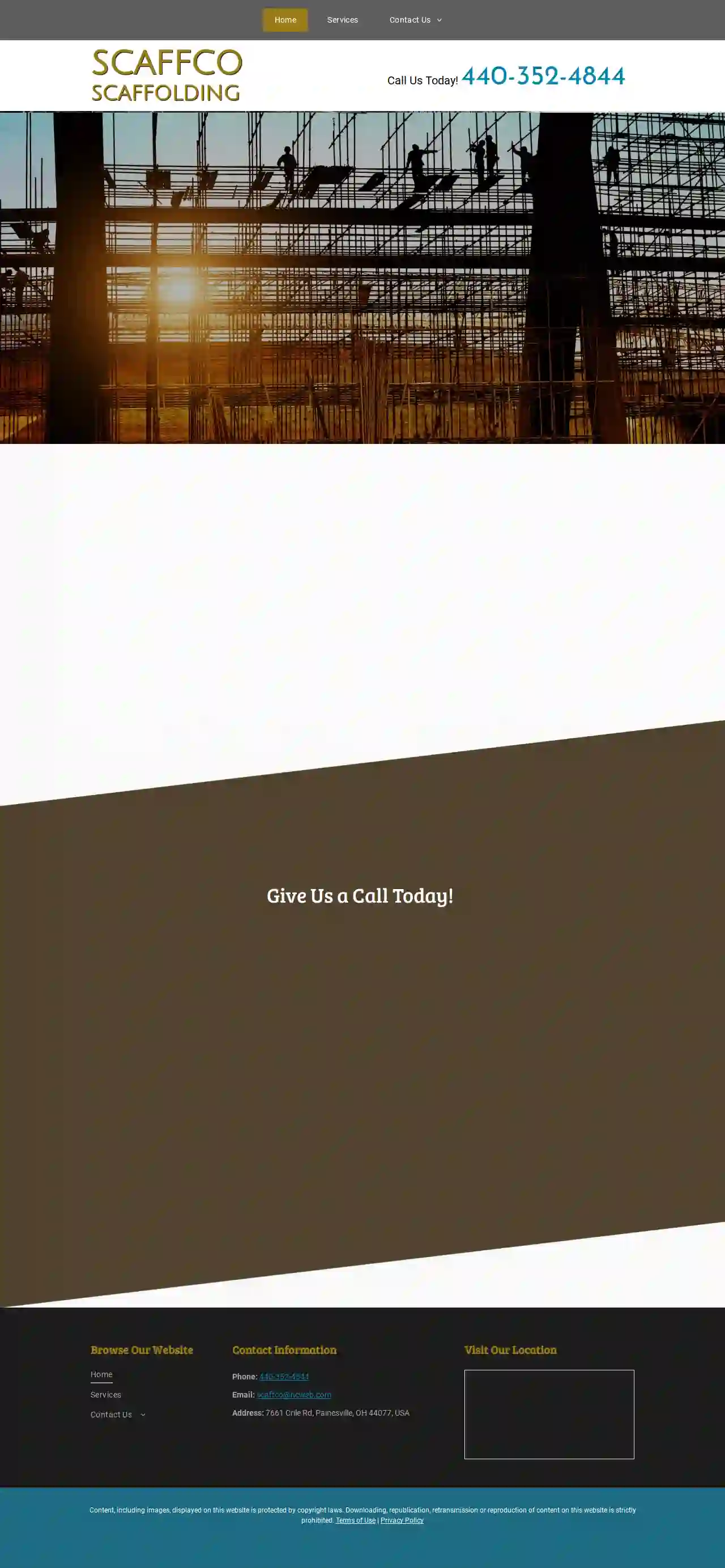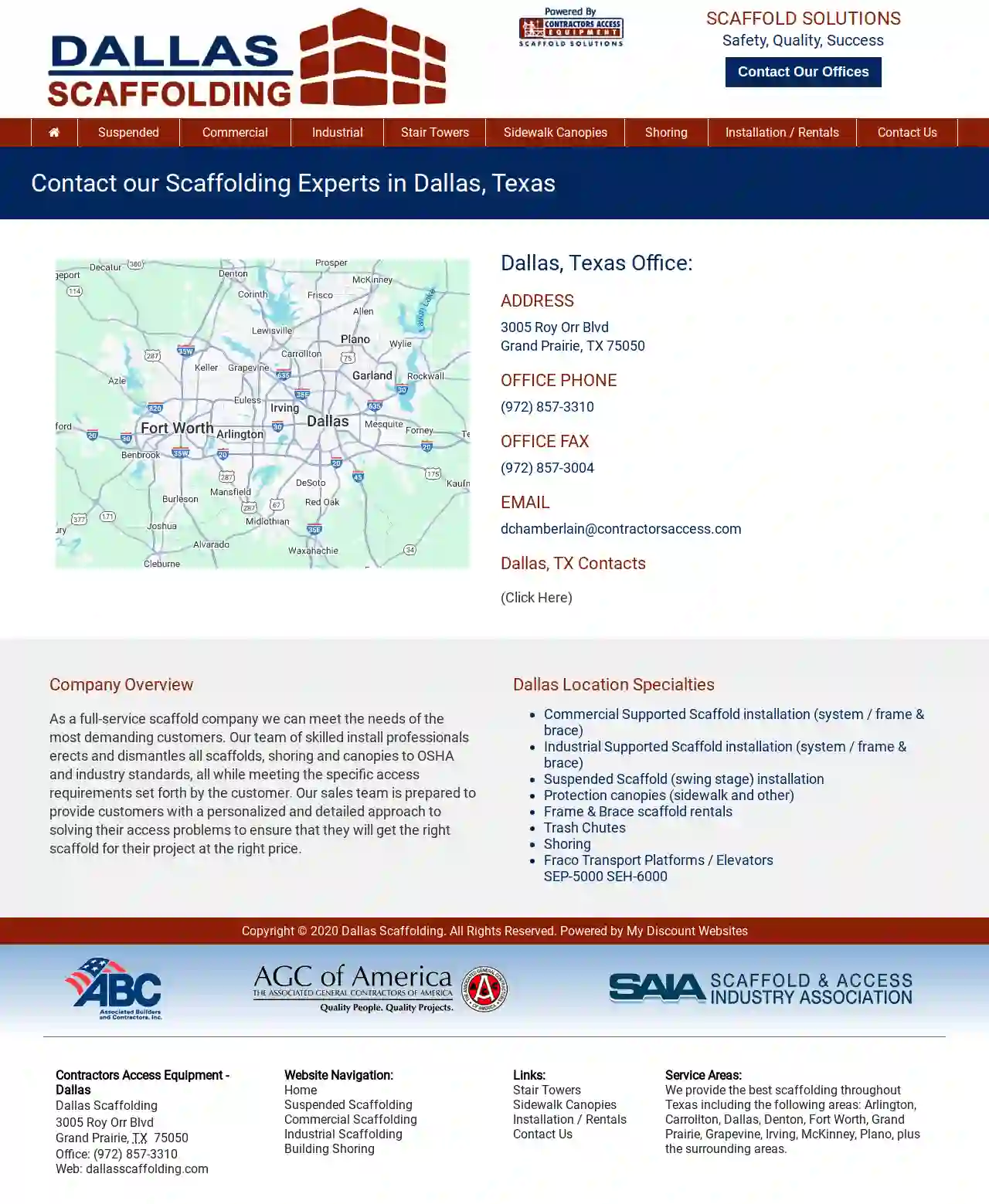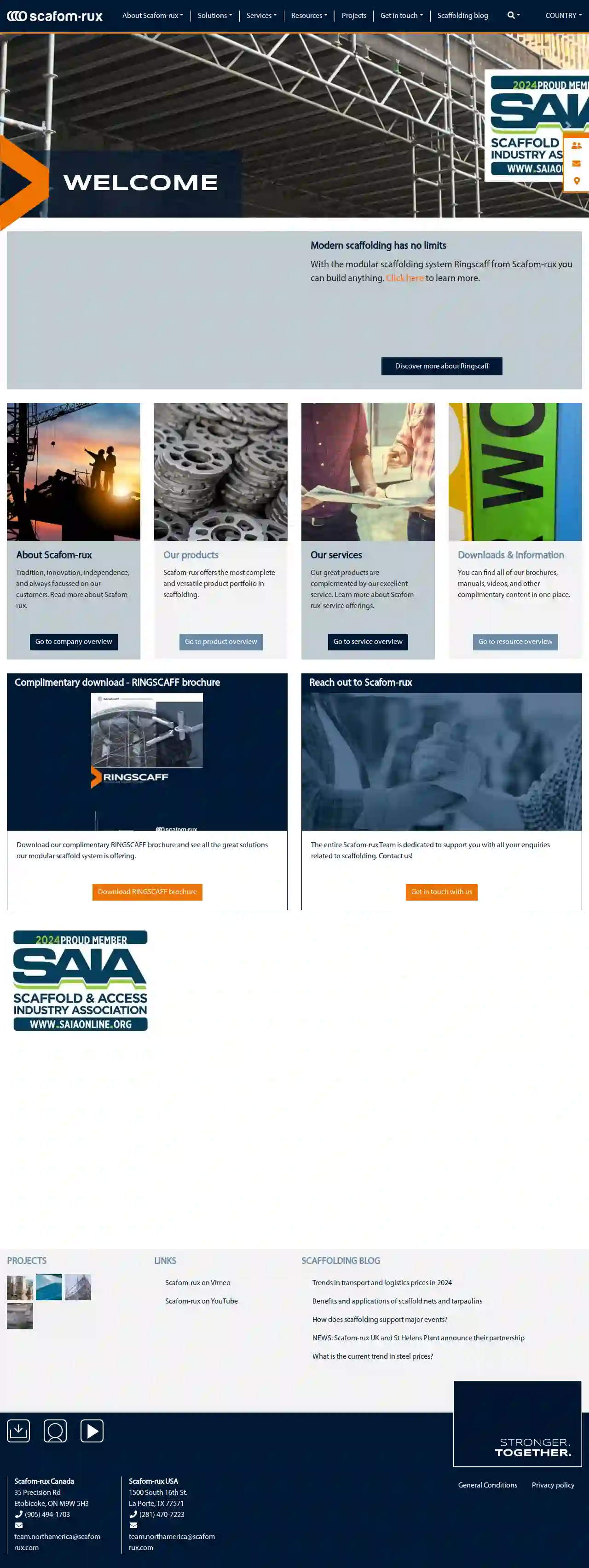Scaffolding Companies Victoria
Find Scaffolding Company in Victoria
Receive up to 3 Scaffolding Solutions quotes for your project today! Compare profiles, reviews, accreditations, portfolio, etc... and choose the best service.

TM Platforms Inc.
250 Royal Oak Road, Cambridge, N3E 0A4, USAt TM Platforms, we pride ourselves on being a professional scaffolding partner that offers 24/7 responsive service, competitive pricing, and expertise to help make your next project run safely and smoothly. As part of the Trade-Mark Industrial group of companies, we are relentlessly committed to safety and offer the knowledge, equipment, and protection products you need for a complete and efficient scaffolding solution. Our team of certified scaffolding installers hold safety paramount in their day-to-day activities and are technically trained to strictly comply with Ontario's construction regulations. We serve customers in Southwestern Ontario, including Kitchener-Waterloo, Cambridge, Guelph, London, Hamilton, Burlington, St. Catharines, Niagara, the GTA, and everything in between.
- Services
- Why Us?
- Accreditations
- Our Team
- Gallery
Get Quote
NYC Scaffolding Rental Service
1775 E 18th St, Unit 1M, Brooklyn, 11229, USScaffolding Rental Service NYC is a well-known and reputed company for providing the best scaffolding services and great customer care during and after work. We assure that our company is known for best scaffolding services and great customers care during and after work. Therefore, our biggest source of identity lies in our customers, they are our ultimate source of motivation and reaching success. Our products have always stood out from the rest of the companies’ scaffoldings, so our work speaks for itself. We have gained respect from people over the years, which we aim to continue to gain more. Our services are known and appreciated throughout the NYC, because we never compromise the quality of our work. Trusting a new company is as hard as it can get, especially nowadays. Things were pretty simpler back in the days, but now with the increase in scams and frauds, people have lost the ability to trust in a company. Especially for a product like a scaffolding, where so many lives are at stake. A badly constructed scaffolding can damage these lives as a result of a hazardous accident. Therefore, our company’s foremost priority is the safety of the construction workers who will use the scaffolding. We build scaffolding with an aim that it can hold a desired amount of people which the customer wants, not only that a scaffolding should be built to hold extra weight than what has been prescribed by the customer. As many times even a tad bit of extra weight on a scaffolding can result in its collapse. So we work by keeping every aspect in mind, so the end product is something which can be used by the customer freely.
- Services
- Why Us?
- Accreditations
- Testimonials
- Gallery
Get Quote
Bill's Equipment & Supply, Inc.
4.146 reviews1234 Main St, Colorado Springs, 80916, USAt Bill's Equipment & Supply, Inc., we've been adding value to your work since 1954. As a family-owned and operated business in the Pikes Peak region, we pride ourselves on providing expert advice, friendly service, and top-quality equipment rentals and sales. From aerial and high-reach equipment to generators and lights, we've got you covered. Our team is dedicated to helping you get the job done efficiently and effectively. Whether you're a contractor or homeowner, we're here to help you find the right equipment for your needs. With three locations to serve you, we're your one-stop shop for all your equipment needs. Trust us to provide you with the best equipment, customer service, and friendly staff. We're committed to helping you succeed, and we're proud to be a part of your project's success story.
- Services
- Why Us?
- Accreditations
- Our Team
- Testimonials
- Gallery
Get Quote
BETCO Scaffolds
52 reviews4336 Director Dr., San Antonio, 78219, USBETCO Scaffolds is a leading scaffolding rental company in Texas, providing top-notch scaffolding solutions for construction projects. With a rich history dating back to 1945, the company has expanded its operations to include branch locations in Houston, Dallas, San Antonio, and Beaumont, serving all of Texas and parts of Oklahoma and Louisiana. BETCO Scaffolds is recognized for its dedication to safety, quality products, and excellent customer service. The company has been awarded the ABC Excellence in Construction Award multiple times and has received the ABC Platinum Safety Award for seven consecutive years. BETCO Scaffolds is privately owned by the Gilbreath Family, spanning three generations, and is known as one of the most innovative scaffolding companies in the country. BETCO's standards for safety and professional service remain their top priority with every project.
- Services
- Why Us?
- Accreditations
- Our Team
- Testimonials
- Gallery
Get Quote
Scaffco Scaffolding
4.85 reviewsPainesville, OH, 7661 Crile Rd, 44077, USScaffco Scaffolding & Supply Company, Inc., is a full-service scaffold company. Renting, delivering, picking up, erecting, dismantling and selling scaffold are what we do best. With more than 35 years of experience in the scaffold industry, our staff is more than capable of handling any and all of the scaffold needs your company may have. If you need a certain application looked at, one of our professionals will come to your job site, inspect the situation and come up with a solution to your needs. Safety is a high priority with our company. Our labor crews will consult with your superintendant to ensure that they are satisfied with the quality of the scaffold build as well as the safety of the job before considering it complete. Scaffco Scaffolding & Supply Company, Inc., is a company that can be of much service to yours. If you have any questions, please contact us at 440-352-4844 or 440-352-1810. Our staff will be able to assist you with any questions you may have. Give Us a Call Today!
- Services
- Why Us?
- Accreditations
- Our Team
- Testimonials
- Gallery
Get Quote
Austin Scaffolding
2.33 reviews520 Tradesman Park Drive, Hutto, 78634, USAustin Scaffolding is a full-service scaffold company that has been providing safe and innovative access solutions to customers in Austin, Texas, and surrounding areas since 2001. Our team of skilled professionals erects and dismantles scaffolds, shoring, and canopies to OSHA and industry standards, meeting the specific access requirements of each project. We offer a personalized approach to solving access problems, ensuring that customers get the right scaffold for their project at the right price. Our services include commercial supported scaffold installation, industrial supported scaffold installation, suspended scaffold installation, protection canopies, frame and brace scaffold rentals, trash chutes, shoring, and Fraco transport platforms/elevators. We are committed to safety, and our first and foremost responsibility is to protect our workers.
- Services
- Why Us?
- Accreditations
- Our Team
- Gallery
Get Quote
Dallas Scaffolding
51 reviews3005 Roy Orr Blvd, Grand Prairie, 75050, USAt Dallas Scaffolding, we pride ourselves on being a full-service scaffold company that can meet the needs of the most demanding customers. Our team of skilled install professionals erects and dismantles all scaffolds, shoring, and canopies to OSHA and industry standards, all while meeting the specific access requirements set forth by the customer. Our sales team is prepared to provide customers with a personalized and detailed approach to solving their access problems to ensure that they will get the right scaffold for their project at the right price. Since 2001, CAE, Inc., has worked hard to become an indispensable resource for our customers. Diverse equipment, multiple branch locations, and skilled employees mean we can design and execute access solutions for almost any project requirement. Our first and foremost responsibility is to protect our workers, which is why safety is our number one value. We believe that providing safe and innovative solutions to your difficult builds results in saving you time, money, and lives. No matter the surroundings, we work with your crew to quickly provide a safe environment for your workers to reach your goals.
- Services
- Why Us?
- Accreditations
- Our Team
- Gallery
Get Quote
City Ladder Co
4.918 reviews123 Main St, Anytown, 12345, USCity Ladder is a leading provider of high-quality ladders, scaffolding, and fall protection equipment. With a wide range of products from top brands like Werner, Knaack, and Metaltech, we cater to the needs of professionals and DIYers alike. Our mission is to provide convenient and safe access solutions for various industries, including construction, roofing, and more. At City Ladder, we pride ourselves on our extensive product knowledge and exceptional customer service. Our team is dedicated to helping you find the right equipment for your specific needs, ensuring that you can work safely and efficiently.
- Services
- Why Us?
- Accreditations
- Our Team
- Testimonials
- Gallery
Get Quote
Scafom-rux North America
515 reviews35 Precision Rd, Etobicoke, M9W 5H3, USScafom-rux is a company that specializes in scaffolding solutions. With a modular scaffolding system called Ringscaff, they can build anything. They offer a wide range of products and services, including scaffolding rental, swing stage services, technical support, and trainings and seminars. Their team is dedicated to supporting customers with all their scaffolding needs.
- Services
- Why Us?
- Gallery
Get Quote
Scafom USA
58 reviewsEtobicoke, ON, 35 Precision Rd, M9W 5H3, USScafom-rux is a leading provider of scaffolding solutions, offering a wide range of products and services designed to meet the needs of various industries. With a strong focus on tradition, innovation, independence, and customer-centricity, Scafom-rux has established itself as a reliable partner for scaffolding requirements. The company's commitment to excellence is reflected in its comprehensive product portfolio, which includes modular scaffolds, swing stages, shoring solutions, props, and accessories. Additionally, Scafom-rux provides a variety of services such as scaffold and swing stage rental, technical support, and training seminars, ensuring that clients receive comprehensive support throughout their projects. Scafom-rux operates globally, with offices in Canada and the USA, and serves clients across multiple sectors.
- Services
- Why Us?
- Accreditations
- Gallery
Get Quote
Over 2,353+ Scaffolding Companies on our directory
Our scaffolding companies operate in Victoria & beyond!
ScaffoldingHQ has curated and vetted Top Scaffolding Businesses in Victoria. Find a top & trustworthy pro today.
Frequently Asked Questions About Scaffolding Companies
- A temporary structure with a larger platform for workers and materials.
- Offers greater stability and working space.
- Suitable for tasks requiring movement and multiple workers.
- Used for higher elevations and more complex projects.
- Used for reaching specific points at height for short durations.
- Less stable than scaffolding, requiring more caution and balance.
- Not suitable for tasks involving heavy materials or extended work periods.
- Stability and Level: The scaffolding is level and firmly supported by a solid foundation.
- Secure Connections: All components (tubes, clamps, fittings) are properly connected and tightened.
- Guardrails and Toeboards: Adequate guardrails and toeboards are in place to prevent falls.
- Platforms and Decking: Platforms are secure, free from damage, and provide adequate working space.
- Access and Egress: Safe access and exit points are available (ladders, stairs).
- Weather Protection: Appropriate measures are in place to protect workers from adverse weather conditions (e.g., wind screens, covers).
- Clearance from Hazards: The scaffolding is a safe distance from power lines, trees, or other potential hazards.
- Scaffolding Tag: The scaffolding tag is up-to-date and displays the last inspection date, maximum load capacity, and any restrictions.
- Always Wear a Safety Harness: Connect your harness to a secure anchor point at all times to prevent falls.
- Keep Platforms Clear: Remove tools, materials, and debris to avoid tripping hazards.
- Never Overload the Scaffolding: Stay within the designated weight limits.
- Be Aware of Your Surroundings: Pay attention to power lines, moving equipment, and other potential hazards.
- Inspect Before Use: Check the scaffolding for any damage or defects before starting work.
- Communicate Clearly: Use hand signals and clear communication to coordinate with other workers.
- Follow Safety Training: Attend and understand all safety training provided by your employer or the scaffolding company.
What is the difference between a scaffold and a ladder?
Scaffolding:
What should I look for during a scaffolding inspection?
What are some tips for working safely on scaffolding?
Can I erect scaffolding myself?
What is the difference between a scaffold and a ladder?
Scaffolding:
- A temporary structure with a larger platform for workers and materials.
- Offers greater stability and working space.
- Suitable for tasks requiring movement and multiple workers.
- Used for higher elevations and more complex projects.
- Used for reaching specific points at height for short durations.
- Less stable than scaffolding, requiring more caution and balance.
- Not suitable for tasks involving heavy materials or extended work periods.
What should I look for during a scaffolding inspection?
- Stability and Level: The scaffolding is level and firmly supported by a solid foundation.
- Secure Connections: All components (tubes, clamps, fittings) are properly connected and tightened.
- Guardrails and Toeboards: Adequate guardrails and toeboards are in place to prevent falls.
- Platforms and Decking: Platforms are secure, free from damage, and provide adequate working space.
- Access and Egress: Safe access and exit points are available (ladders, stairs).
- Weather Protection: Appropriate measures are in place to protect workers from adverse weather conditions (e.g., wind screens, covers).
- Clearance from Hazards: The scaffolding is a safe distance from power lines, trees, or other potential hazards.
- Scaffolding Tag: The scaffolding tag is up-to-date and displays the last inspection date, maximum load capacity, and any restrictions.
What are some tips for working safely on scaffolding?
- Always Wear a Safety Harness: Connect your harness to a secure anchor point at all times to prevent falls.
- Keep Platforms Clear: Remove tools, materials, and debris to avoid tripping hazards.
- Never Overload the Scaffolding: Stay within the designated weight limits.
- Be Aware of Your Surroundings: Pay attention to power lines, moving equipment, and other potential hazards.
- Inspect Before Use: Check the scaffolding for any damage or defects before starting work.
- Communicate Clearly: Use hand signals and clear communication to coordinate with other workers.
- Follow Safety Training: Attend and understand all safety training provided by your employer or the scaffolding company.